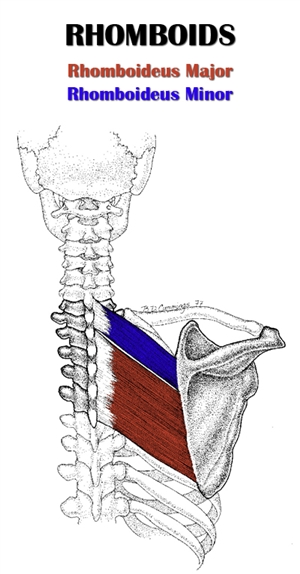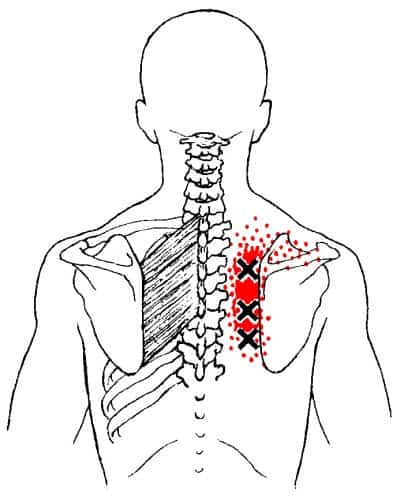The rhomboid major and minor (L. rhomboideus, parallelogram ; major, larger ; minor, smaller.) are two muscles located between the shoulder blades and spinal column.

If you took geometry, you might’ve guessed that they’re named after the rhombus shape, which they both resemble.
Acting on the shoulder blades, both of these muscles are prime movers in scapular retraction and scapular downward rotation.
The rhomboids are part of the deep posterior axioappendicular (extrinsic shoulder) muscle group.
They’re situated inferior to the levator scapulae, superior to the lats, deep to the middle trapezius, and superficial to the serratus posterior superior and thoracic spinal erectors.
The rhomboids originate from the lower cervical and upper thoracic vertebrae.
The parallel-oriented fibers of both muscles run inferolaterally and insert on the medial border of the scapula, forming flat quadrate muscle architectures.
Table of Contents
Also Called
- Rhomboidei (rhomboideus major, rhomboideus minor)
- Upper back
Origin, Insertion, Action & Nerve Supply
| Muscle | Rhomboid Major | Rhomboid Minor |
|---|---|---|
| Origin | Spinous processes of T2-T5 | Spinous processes of C7-T1 |
| Insertion | Medial border of the scapula (from below scapular spine to inferior angle of scapula) | Medial border of the scapula (in line with scapular spine) |
| Action |
|
|
| Nerve Supply | Dorsal scapular nerve (C4-C5) | Dorsal scapular nerve (C4-C5) |
Exercises:
Note: The table below only includes exercises featuring scapular retraction, since that is what targets the rhomboids most directly. These are the exact same exercises that target the middle trapezius.
The rhomboids are trained more indirectly in rear deltoid exercises and lat exercises.
Barbell Exercises:
- Bent over shrug (head-supported)
- Incline shrug
- T-bar shrug
- Bent over row
- Underhand bent over row
- Lying row (cambered bar)
- Incline row (cambered bar)
- T-bar row
Dumbbell Exercises:
- Bent over shrug (head-supported)
- Incline shrug
- Bent over row
- Lying row
- Incline row
- Flat bench T, W or I raise
- Incline T, W or I raise
- Bent over T, W or I raise (head-supported)
- Prone cobra (arms in T, W or I position)
Cable Exercises:
- Bent over shrug
- Standing horizontal shrug
- Seated horizontal shrug
- Incline shrug
- Bent over row
- Standing row
- Seated row
- Lying (supine) row
- Incline row
- Face pull
Machine Exercises:
- Bent over shrug
- Seated horizontal shrug
- T-bar shrug
- Bent over row
- Seated row
- Underhand seated row
- Incline row
- T-bar row
Weighted Exercises:
- Inverted (supine) shrug
- Inverted row
Bodyweight Exercises:
- Inverted (supine) shrug
- Inverted row
- Flat bench T, W or I raise
- Incline T, W or I raise
- Bent over T, W or I raise (head-supported)
- Prone cobra (arms in T, W or I position)
Isometric Exercises:
- Flat bench T, W or I hold
- Incline T, W or I hold
- Bent over T, W or I hold (head-supported)
- Prone cobra hold (arms in T, W or I position)
Stretches & Myofascial Release Techniques:
Stretches
These are the same techniques use to stretch the middle trapezius fibers.
- Cross-body rhomboids stretch
- Kneeling cross-body rhomboids stretch (arm against floor)
- Hugging stretch
- Fixed bar rhomboids stretch
- Fixed bar back stretch
Self Myofascial Release Techniques
When using these techniques, give special attention to the common trigger points shown in the image below.
Tool
- Foam roller
- Lacrosse ball
- Backnobber II
- Medicine ball
Common Issues:
- Inhibited/Lengthened Rhomboids: The rhomboid major and rhomboid minor are both inhibited and lengthened in individuals with upper crossed syndrome (UCS). The scapular protraction that goes hand in hand with UCS puts the rhomboids in a chronically stretched out and inhibited state. At the same time, this facilitates the pectoralis minor, which is an antagonist of the rhomboids during scapular retraction. This can result in reduced range of motion and weakness during scapular retraction. This increases risk of shoulder injury on bench press due to the inability to keep your shoulder blades packed down and together in order to stabilize your shoulder girdle. Additionally, the pec minor will become synergistically dominant over the rhomboids in movements involving scapular downward rotation, where they would normally work together. This can cause poor technique and shoulder instability during exercises like pull ups and lat pulldowns.
- Overactive/Short Rhomboids: While not as common as inhibition/excessive lengthening, the rhomboids can become overactive and shorter in some cases. Specifically, this tends to happen most in powerlifters who do a disproportionate amount of training volume on exercises involving the movement of scapular retraction (e.g. row variations), combined with a lot volume on exercises where the position of scapular retraction is statically held (i.e. bench press variations). This causes “rhomboid dominance,” where the rhomboids become tighter and shorter, and the serratus anterior becomes inhibited and lengthened since the scapulae are constantly pulling against it. Since the serratus anterior plays such an important role in arm elevation (via scapular upward rotation), the biggest negative impact of rhomboid dominance is that it can restrict overhead mobility.
Training Notes:
- If you have inhibited/lengthened rhomboids, do the following:
- Increase training volume and training frequency on direct rhomboid/mid trap exercises. If you have a lot of difficulty getting the scapulae to retract during rows, do exercises that will focus specifically on improve motor control during scapular retraction – For this, I recommend incline shrugs and unilateral incline T raise. Gradually increase the weight over time. Once you feel strong enough with scapular, start integrating different row variation with light weight, and go from there.
- Release and stretch the pectoralis minor, pectoralis major and latissimus dorsi. These are the muscles most responsible for inhibiting the rhomboids.
- The above bullet points are a good start for treating your rhomboids dysfunction. As mentioned earlier, upper crossed syndrome is often the source of the problem. If this is the case in your situation, refer to how to fix upper crossed syndrome (article coming soon).
- If you have tight/short rhomboids (rhomboid dominance), do the following:
- Decrease your total training volume on row variations (which involve the movement of retraction) and bench press variations (which involve holding the static position of retraction).
- Release and stretch your rhomboids on a daily basis, especially after doing exercises that train them.
- Increase your training volume and training frequency on serratus anterior exercises.
- Allow your scapulae to fully protract at the bottom of the rep on row exercises. Don’t hold it in that position for an extended period of time, since letting a heavy load pull against it like that could be potentially harmful. Rather, allow the scapulae to go to the end of the protraction range of motion for just a moment before pulling the weight back up.
- If your lower trapezius muscles are also inhibited/long, start doing exercises to activate and strengthen them. The Y raise exercise will isolate them. Overhead shrugs will train them along with the serratus anterior. See lower trapezius exercises for more options.
- Here are a few general tips for improving your technique on rhomboid exercises:
- During the concentric rep, focus on retracting your scapulae, while keeping them depressed. Your should feel your rhomboids doing a lot of the work. You should also feel the lower trapezius contracting isometrically since they are working to keep the lower trapezius depressed.
- Maintain thoracic extension to allow proper movement of the scapulae over the ribs.
- During the eccentric rep, allow you scapulae to “glide around your rib cage.”
- For rows, don’t rely on your arms to pull the weight up. If you can’t fully retract your scapulae and feel it in your back, then you need to reduce the weight and work on your technique.



pictures on the exercises and stretches would be very beneficial!!
Hi Kody, I appreciate the feedback. I definitely want to add pictures in the future. I’ve got a long to-do list for content, and this is on it.
All the best,
Alex
Hi Alex,
The more I read of your articles the more I appreciate how straightforward they are. So much of what you read on the net is over complicated and confused it’s refreshing to see something explained simply and succinctly.
I’d love to read about a fix for upper crossed syndrome if you ever had time!
Cheers,
Reg
Thanks, Reg! The Upper Crossed Syndrome article has unfortunately been on the backburner for some years now. Hopefully I eventually get to it, but I’ve got so many other pieces lined up that I can’t say for sure.